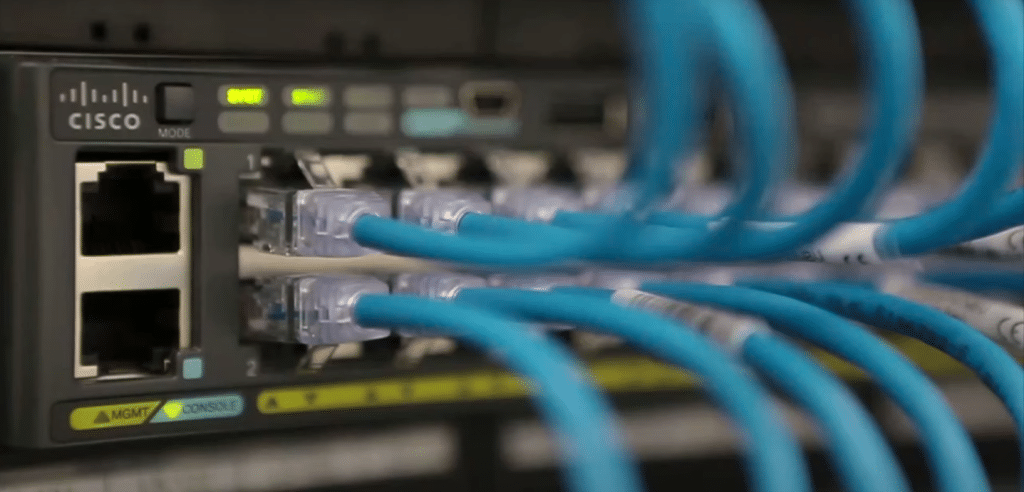What is Auto-MDIX Cisco? – Everything to Know
Auto-MDIX (Automatic Medium-Dependent Interface Crossover) is a feature supported on Cisco switches and routers that automatically detects and configures the required cable type (straight-through or crossover) for Ethernet connections. This eliminates the need for network administrators to select or use specific cables when connecting devices manually.
Historical Context
In the past, connecting two network devices (e.g., switch-to-switch or PC-to-PC) required a crossover cable, while connecting a device to a switch (e.g., PC-to-switch) needed a straight-through cable. Auto MDIX simplifies this process.
Before Auto-MDIX, network engineers relied on manual cable selection, which led to errors and downtime. The IEEE 802.3ab-1999 standard formalized Auto MDIX, enabling devices to automatically adjust transmit (TX) and receive (RX) pairs, regardless of cable type. In 2025, Auto MDIX remains vital as networks expand with 10 Gbps and 400 Gbps links, reducing manual errors in high-speed deployments.
How Auto-MDIX Works
Auto-MDIX uses signal detection to determine cable type and adjusts transmit (TX) and receive (RX) pairs, ensuring seamless communication. In 2025, this is essential for high-speed interfaces like 10 Gbps and beyond.
Auto MDIX operates at the OSI model’s physical layer (Layer 1). The interface sends test signals to detect cable polarity when a link is established. Auto MDIX internally “crosses” the TX/RX pairs to mimic a crossover connection if a straight-through cable is used between two switches.
Understanding MDI/MDIX Ports and Cable Standards
MDI (Media Dependent Interface)
The workstation computer or laptop port in networking is called MDI (Media Dependent Interface). In contrast, the ports on network switches are labeled MDIX (Media Dependent Interface with Crossover). This distinction is crucial in ensuring seamless communication.
RJ45 jacks, the connectors attached to copper twisted pair cables, are intricately crimped to facilitate communication. The transmit pair pins on one end are connected to receive pair pins on the other, forming a reliable communication channel. MDI Ports Transmit data on pins 1 and 2 and receive data on pins 3 and 6.
MDIX (MDI Crossover)
MDIX (Media Dependent Interface with Crossover) is a hardware-level feature that internally crosses the transmit (Tx) and receive (Rx) signal pairs in an Ethernet port. This allows two network devices to communicate without requiring a physical crossover cable when connecting similar interfaces (e.g., switch-to-switch or PC-to-PC). MDIX Ports receive data on pins 1 and 2 and transmit on pins 3 and 6.
Technical Mechanism (Pin Configuration)
Standard MDI Port (e.g., on a PC):
- Tx+: Pin 1 | Tx–: Pin 2
- Rx+: Pin 3 | Rx–: Pin 6
MDIX Port (e.g., on a switch)
- Rx+: Pin 1 | Rx–: Pin 2
- Tx+: Pin 3 | Tx–: Pin 6
Configuration on Cisco Devices
Most modern Cisco switches enable Auto MDIX by default. For manual configuration in 2025, use these updated steps:
New Configuration Steps:
Enable Auto-MDIX on Cisco Switch
Switch# configure terminal
Switch(config)# interface GigabitEthernet0/1
Switch(config-if)# mdix auto
Verify Status
Switch# show controllers ethernet-controller GigabitEthernet0/1 phy
Look for “Auto-MDIX: On” in the output.
It is disabled on fiber interfaces (e.g., SFP modules) and Power over Ethernet (PoE) ports.
For legacy 10 Mbps devices, manually set speed/duplex:
Switch(config-if)# speed 10
Switch(config-if)# duplex half
When to Use Auto-MDIX
It is ideal for environments with mixed or unknown cable types, reducing deployment time and errors.
New Use Cases:
- Ad-hoc Networks: Connecting devices in temporary setups (e.g., conference rooms).
- Uplink-Free Switches: Linking switches without dedicated uplink ports.
- BYOD (Bring Your Own Device): Simplifying connections for unknown client devices.
In 2025, Auto MDIX supports rapid deployment in smart city networks and IoT ecosystems, where diverse device connections are common.
Troubleshooting Auto-MDIX
Common Issues & Fixes:
Link Not Up:
- Ensure the cable is functional and within length limits (≤ 100m for Cat5e/6).
- Disable Auto-MDIX and force speed/duplex:
Switch(config-if)# no mdix auto
Switch(config-if)# speed 100
Switch(config-if)# duplex full
Legacy Device Compatibility:
- Older 10 Mbps hubs may not support Auto MDIX. Use a crossover cable instead.
As of 2025, use network monitoring tools like Cisco DNA Center to diagnose Auto-MDIX issues in real-time, especially in large-scale environments.
Auto-MDIX vs. Manual Configuration
| Feature | Auto MDIX | Manual Configuration |
|---|---|---|
| Cable Detection | Automatic | Requires crossover/straight |
| Use Case | Modern setups | Legacy systems (pre-2000s) |
| Flexibility | High | Low |
Real-World Example
Imagine connecting two Cisco Catalyst 2960 switches with a straight-through cable. Without Auto MDIX, the link would fail. With Auto MDIX enabled, the switches automatically adjust, establishing a successful connection.
Added Anecdote:
A client once reported a “dead” switch port. The issue was a mismatched cable connecting two switches. Enabling Auto MDIX resolved it within minutes!
Conclusion
Auto MDIX is a game-changer that simplifies Ethernet connectivity. Its ability to automatically adjust to port types enhances flexibility and efficiency, making it indispensable for 2025 networks with IoT and 5G advancements.
FAQs
-
Auto-MDIX automatically detects and corrects Ethernet cable types (straight-through or crossover), eliminating manual configuration errors.
